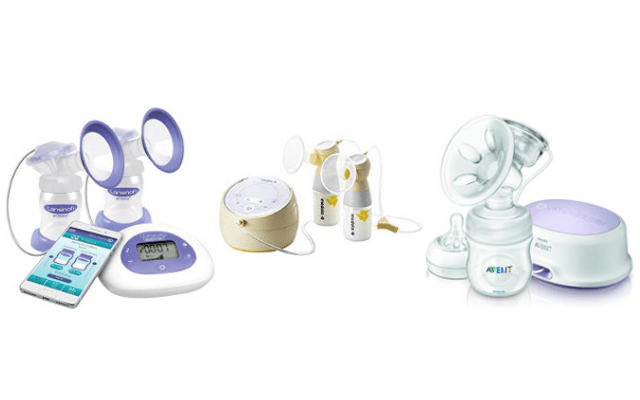 Breast milk provides the nutrition needed for your baby. However, work or activities of daily life might drag you away from being there to nurse your child.
Breast milk provides the nutrition needed for your baby. However, work or activities of daily life might drag you away from being there to nurse your child.
The good news is you can still give your little one their daily dose of mother’s milk thanks to breast bumps.
But not every woman is thrilled at the idea of pumping. It’s true that it can be a cumbersome process, but one that is necessary.
Pumping milk keeps the supply flowing and it also prevents engorgement.
It’s understandable to be intimidated by the whole process but the task can be made much easier with the use of automatic breast pumps.
This article will look into the best automatic breast pumps available that suit different preferences.
Breast Pumping Questions
A breast pump allows you to deposit food for your baby for when you have to go to work or need to leave the house.
While it is always recommended to breastfeed your child – for the first four to eight weeks at least – certain instances require pumping of milk much earlier. These include:
- A baby who is unable to breastfeed, born premature, or has a health issue.
- A baby who loses weight because they can’t get enough milk from nursing.
If you are also headed back to work soon, it might help to pump three weeks before your return date to ensure enough milk is stored.
Another breast pumping concern is the frequency of the process. There is no strict rule, but there are guidelines:
- pump when a baby is being bottle fed
- pump twice a day when preparing to get back to work
- pump every three hours while at work
You can also take note of how many bottles your baby can consume while you’re out of the house. That can help determine the number of times you have to pump while at work.
With regards to how much milk should be pumped, the exact volume will depend on the actual supply. Generally, though, mothers make about a liter a day.
The general “rule” is to stop pumping when your breasts feel soft and emptied. Keep in mind that a pumping session can last anywhere from 15 to 30 minutes.
Automatic Breast Pump Benefits
One of the best reasons to invest in an automatic breast pump is the convenience. In short, you don’t have to work as hard to get milk out of you.
With an electric pump, all you have to do is make sure the cup is in place. After that, it does what it’s supposed to do: suck milk for transfer into a bottle.
Automatic pumps are also time savers: they get more milk in less time than their manual counterparts.
You also have two choices when it comes to electric pumps: battery-powered or one that needs an electric outlet. There are obvious benefits to the former as you can take them anywhere but you also have to spend on batteries.
Modern advances in this day and age have also made their way to breast pumps. You can find pumps with a companion app to track feeding. Or you can get pumps that allow you to adjust suction levels.
On that same note, the availability of different models makes automatic breast pumps a more favorable choice. You can choose a device that best caters to your wants and needs.
Factors to Consider When Choosing an Automatic Breast Pump
It would be unfair to just buy the first pump you see. Each device is different and brings with it their own pros and cons.
As such, it’s always better to think about what you want out of a breast pump then make a decision from there.
Doing so allows you to choose a device that not only suits your preference but also makes the process a lot easier.
That said, here are some factors to consider before buying an automatic breast pump:
- The frequency of pumping: If you’re doing it more than once in a single day, getting a double electric breast pump, which pumps both breasts at once, is a time saver. Otherwise, a single electric breast pump works just fine.
- Suction strength: It’s very difficult to equal your baby in sucking milk from the teat. This is why you should get a device that could at least manage the task rather well.
- Noise levels: Some machines tend to be rather noisy. So it might be best to get one that doesn’t make too much noise if you need to be in a place where silence is sacred.
- Comfort level: Pumping milk is not a pleasant activity and the device you use should at the very least not make things worse.
- Portability: You’re going to be carrying this around so it’s best to choose one that wouldn’t be a burden to bring along.
- Ease of set up: One of the best advantages of nursing overpumping is that babies immediately suck on a teat while you still have to set up a machine. So a good device is one that doesn’t take too long to get ready and has a simple set-up process.
- Additional features: Breast pumps suck milk then send them into a bottle. But some machines to more, like having an app to track feedings.
- Power source: Is it going to be powered batteries or one that needs an electric socket?
Great Features to Have in a Breast Pump
The breast pump you purchase isn’t going to be perfect. You have to make compromises where you can.
That said, there are certain features that would be nice to have. These include:
- an adjustable vacuum for comfort
- a cycling time (the amount it can suck per minute) that is better than a manual type
- a double pump to save time
7 of the Best Automatic Breast Pumps
Once you get a list of all the features you want in an automatic breast bump, you have to make a decision on which model to purchase.
However, that task is made difficult by having many options to choose from. To help you out, we’ve provided some of the best automatic breast pumps to narrow down the field.
1. Medela Sonata Smart Double Electric Breast Pump
This is the automatic breast pump for the tech-savvy mom. You can keep track of pumping sessions when you connect the pump to the MyMedela app on your smartphone via Bluetooth.
The collected data can also be exported into a spreadsheet that you can then share with your pediatrician. Note: they will ask you how things are going to having a record helps you give valuable answers.
Other than track feeding, the app provides information and how-tos about breastfeeding, lactating, and parenting. Even more useful: the user manual and quick-start guide are accessible via the app.
But enough about the technology that comes with this smart pump. How well does it perform its main function?
The answer: very well. And it does it without making a noise, which is much appreciated.
The Medela Sonata Smart Breast Pump comes with an intuitive digital touchscreen display for easy operation. It has 2-Phase Expression Technology that can get more milk in less time.
Medela makes use of research-based pump technology in order to mimic the natural nursing pattern of a baby.
You can also choose Responsive Pump Technology, where suction is automatically adjusted to your body and environment.
Pumping with this smart electric breast pump doesn’t hurt and you can choose from different rhythm options. The back-lit display is also very useful when used in low-light conditions.
The Medela Sonata’s power source is a rechargeable lithium-ion battery that can last more than three hours on a single charge.
The pump comes with a black tote, making it not only portable but quite stylish.
Pros
- It is easy to use.
- It is quiet when in use.
- It adjusts suction to body and environment.
- It connects to an app, which provides useful data.
Cons
- It can get quite tricky to pair with Bluetooth.
2. Philips Avent Comfort Double Electric Breast Pump
Who doesn’t crave a simple breast pumping machine? The Philips Avent Comfort Double Electric Breast Pump is easy to assemble, either intuitively or following the instruction booklet.
It also offers moms a convenience by being able to pump while in a sitting position. Other models require a little leaning forward to ensure milk gets into the bottle.
The breast shield is soft and comfortable. The machine offers three expression settings, as well as a choice of suction strength.
Like the Medela Sonata, it comes in a travel bag but differs in that it’s not digital. But that shouldn’t be held against it as the five-button machine is simple to operate.
Pros
- It has simple settings.
- It has good suction strength.
- It has a cover for the breast shields to keep lint and other debris away.
Cons
- It can get quite noisy.
- It doesn’t have a rechargeable battery.
3. Lansinoh Signature Pro Double Electric Breast Pump
Automatic breast pumps don’t come cheap, but there are pocket-friendly varieties like the Lansinoh Signature Pro Double Electric Breast Pump.
This is a pump that best serves mothers who pump and breastfeed. You can choose from three pumping styles, each with eight suction levels.
The model also hits the mark when it comes to ease of assembly and use. One of the device’s most interesting features is the timer, which lets you know how long you’ve been pumping.
Although it doesn’t feature a complicated operation, it does have few drawbacks that may or may not dissuade you from choosing it. On occasions, you will experience leaking around the nipple shield.
Also, you will need to buy a pumping bustier – which is sold separately – if you want to pump milk without using your hands.
Despite the limitations, the Lansinoh Signature is a simple, good quality device that won’t break the bank.
Pros
- It is easy to put together and use.
- It comes with a backlit LCD screen for use in low-light situations.
Cons
- It needs a separate pumping bustier for hands-free pumping.
- It leaks around the nipple shield occasionally.
4. Medela Swing Single Electric Breast Pump
Unlike the previous entries in this list, this model from Medela can work on one breast.
As such, this is the best option if you’re not really pressed for time or only need to pump milk occasionally. Otherwise, you’re better off choosing one of the double electric breast pumps.
Like any other Medela model, the Swing is easy to use and operate. It also features the popular 2-Phase Expression Technology that maximizes the amount of milk to be extracted.
The Medela Swing is operated either by single-use AA batteries (four of them) or you can use the power adapter that comes with it.
Although it doesn’t come with a timer or a backlit display, it’s still a device that requires minimal fuss to operate.
Pros
- It doesn’t need much fuss to use and operate.
- It has good suction strength.
Cons
- It pumps milk one breast at a time.
5. Spectra Baby USA S2 Plus premier Electric Breast Pump, Hospital Grade
The S2 can be used either as a single or double pump. Thanks to its closed-system design, a barrier separates the milk from the pump.
It has a good suction strength and doesn’t require complicated procedures to operate. You can set the pumping program to suck at a speed that is most comfortable.
The S2 also comes with a timer and night light – both being helpful when used in low-light conditions.
Pros
- It is not difficult to operate.
- It allows settings to be customized for comfort.
- It is a closed-system device.
Cons
- It has a rather short tubing, which can be an inconvenience.
6. Philips Avent Single Electric Comfort Breast Pump
This is the second Philips Avent model on this list, but this time it’s a single pump device. Like the double pump version, this works even when you’re in a sitting position.
It can stimulate milk flow thanks to its soft massaging cushion. And you can choose three expression settings: low, medium, or high – depending on your preference.
The Single Electric Comfort Breast Pump from Philips is also easy to store and is portable enough to carry along during travels.
The operation is fairly easy: pumping can begin with just a touch of a button.
Pros
- It can start operations with just a touch of a button.
- It is compatible with other products in the Avent line.
Cons
- It is a bit loud.
- It is not as efficient as a double pump.
7. Baby Steps Independent Double Electric Breast Pump
Coming in at 0.9 pounds, the Baby Steps Independent Double Electric Breast Pump won’t be a burden to bring along to work or while traveling.
The device mimics the natural suckling action of a baby, provided in two phases: stimulation and expression. In addition, there are nine suction modes available for each phase so you can adjust for comfort.
With a closed-system diaphragm, the pump is able to provide anti-backflow protection that separates milk and air.
Pros
- It is not complicated to use and operate.
- It can be adjusted for maximum comfort.
Cons
- It doesn’t use rechargeable batteries or single-use batteries.
Conclusion
There are obvious benefits to using an automatic breast pump over a manual variety. However, they will always be the pricier version.
But with higher prices comes some nifty features as well. Depending on your preference, you can get electric pumps that come with a companion app.
You can also choose a pump that doesn’t make too much noise should you need to pump in spaces that value silence or so you don’t wake your baby.
There are many models to choose from, each with a feature that suits your preference.
This list presents the very best automatic breast pumps so your field of choices is narrowed down. You just have to decide what you want in a breast pump and the amount you’re willing to invest in.
Always keep in mind to make a choice that suits your preference. Doing so ensures you’ll have a comfortable and lovely breast pumping experience.











I am a new Moms. I am using Lucina care breast pump. It’s Very easy to used and save time & money because Lucina Care provides the free breast pumps through insurance. I really do enjoy with it.